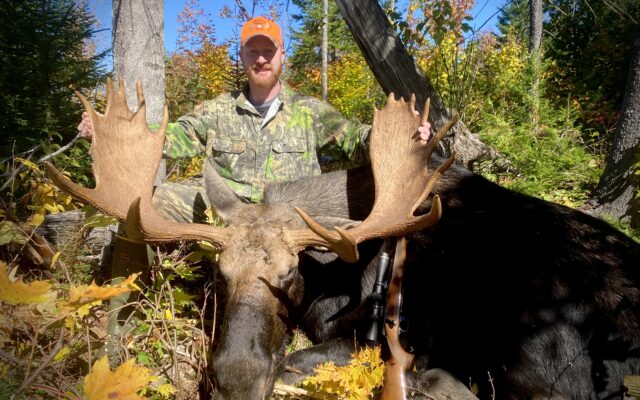
Warm weather could be a factor in Maine’s 42nd moose hunt
By Pete Warner, Bangor Daily News Staff
The calendar says fall began in the early morning hours of Saturday, Sept. 23. Moose hunters in Maine hope the change of seasons also ushers in more autumn-like temperatures.
Cooler weather would be most welcome among the more than 1,000 hunters and their sub-permittees who will hit the ground on Monday, Sept. 23 for the first week of the 2023 moose season.
Hunters will be targeting bulls only Sept. 25-30 and will fan out across 12 different Wildlife Management Districts in search of Maine’s largest big-game animal.
The quest to put some delicious meat on the table, and maybe a set of antlers above the mantle, has proven more challenging in recent years.

BULL MOOSE — In this October 2022 photo, Bangor Daily News Outdoors contributor Chris Sargent poses alongside the bull moose he harvested in Wildlife Management District 6.
Last year, during the traditional portion of the moose season — not including the state’s special adaptive hunt targeting antlerless moose — hunters had the most difficult time in the history of the modern hunt, which began in 1980.
Sixty-two percent of hunters (2,199 of 3,530) successfully killed a moose, according to data released by the Maine Department of Inland Fisheries and Wildlife. The previous low of 65.3 percent occurred in 2014.
The harvest came on the heels of a 2021 season when 68 percent of hunters were successful, which at that time ranked as the third lowest. It is part of an ongoing decline in moose hunting success. Fewer than 70 percent of hunters killed a moose, which was the third time that happened in the last four years.
DIF&W moose biologist Lee Kantar, the state’s expert on the animals, said qualifying harvest numbers has become increasingly difficult.
“We’ve changed so many things since the beginning of the moose hunt that it’s not really comparable over time,†Kantar said in evaluating the 2022 season.
There have not only been fewer moose on the landscape, in large part due to the mortality caused by winter tick infestations, but frequent changes to season dates, quotas, weather and even hunter strategies have occurred over the years.
Warmer weather, during both the September and October bull seasons, is among the key factors suppressing harvest numbers. Heat during the daytime hours reduces moose movement and causes them to remain in cooler, shadier areas rather than spending time out in the open under the sun.
Next week’s forecast for Ashland is calling for temperatures ranging from 62 degrees on Monday to 72 on Thursday and Friday, averaging nearly 69 degrees. And nighttime temperatures are expected to get down only into the 40s.
While moose will be active because they are well into their mating season, they may again be more difficult to find.
Kantar previously said the unfamiliarity of many hunters with moose habitat and behavior, coupled with a reliance on an outdated belief system from the 1980s — when clearcuts were more common, the animals were more visible and success rates higher — cannot be overlooked.
“The success part is up to hunter behavior,†Kantar said. “There’s a lot of homework there. There’s a lot of ground to cover.â€
He also said the nature of moose hunting is such that, even with sufficient preparation, sometimes a hunt simply does not come together.
More than 64 percent of the state’s available moose permits (2,645) are issued for the first two bull-only weeks, Sept. 25-30 and Oct. 9-14. There are another 910 antlerless permits on the table for the week of Oct. 23-28.
In addition, the 550 adaptive hunt permits are spread out across four weeks: Oct. 16-21, Oct. 23-28, Oct. 30-Nov. 4 and Nov. 6-11.